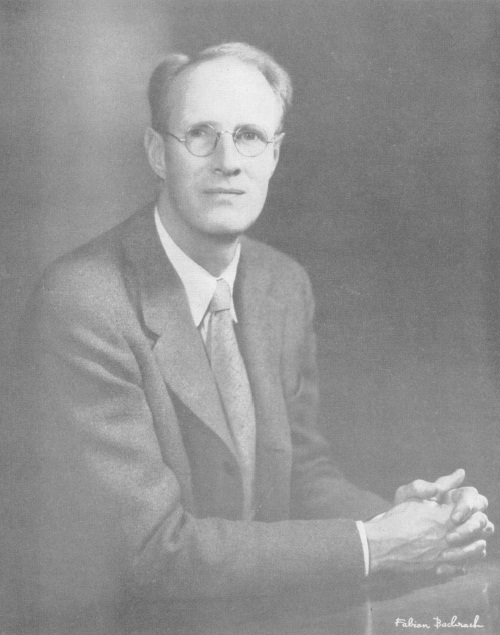<Back to Index>
- Plant Physiologist Robert Emerson, 1903
- Plant Biochemist Robin Hill, 1899
PAGE SPONSOR

Robert Emerson (November 4, 1903 – February 4, 1959) was an American scientist noted for his discovery that plants have two distinct photosynthetic reaction centres.
Emerson was born in 1903 in New York City, the son of Dr. Haven Emerson, Health Commissioner of New York City, and Grace Parrish Emerson, the sister of Maxfield Parrish. Emerson was the brother of John Haven Emerson the inventor of the iron lung.
He married Claire Garrison, and they had three sons, and a daughter.
Emerson received a master's degree in 1929 from Harvard, and received his doctorate from the University of Berlin working in the laboratory of Otto Warburg.
Thomas Hunt Morgan invited him to join the Biology Division at the California Institute of Technology, where he worked from 1930 to 1937, and again for a year in 1941 and 1945. From 1942 to 1945 he worked on producing rubber from the guayule shrub for the American Rubber Company.
In 1947 he moved to the Botany Department of the University of Illinois, where he remained for the rest of his life.
Emerson's first "important" result was the quantification of the ratio of chlorophyll molecules to oxygen molecules produced by photosynthesis. Emerson and William Arnold found that "the yield per flash reached a maximum when just 1 out of 2500 chlorophylls absorbed a quantum".
Next, in 1939, Emerson demonstrated that between 8 and 12 quanta of light were needed to produce one molecule of oxygen. These results were controversial, as they contradicted Warburg who reported 4, then 3, and finally 2 quanta. This dispute was settled after the death of both men, and it is now agreed that Emerson was correct, and the accepted modern value is 8 - 10 quanta.
In 1957, Emerson reported results that are now called the Emerson effect, the excess rate of photosynthesis after chloroplasts are simultaneously exposed to light of wavelength 670 nm (far red light), and 700 nm (red light).
These results were later shown to be the first experimental demonstration that there are two photosynthetic reaction centres in plants.
Emerson died in the crash of American Airlines Flight 320 in New York City.

Robert Hill (April 2, 1899 – March 15, 1991), known as Robin Hill, was a British plant biochemist who, in 1939, demonstrated the 'Hill reaction' of photosynthesis, proving that oxygen is evolved during the light requiring steps of photosynthesis. He also made significant contributions to the development of the Z-scheme of oxygenic photosynthesis.
Hill was born in New Milverton, a suburb of Leamington Spa, Warwickshire. He was educated at Bedales School, where he became interested in biology and astronomy (he published a paper on sunspots in 1917), and Emmanuel College, Cambridge, where he read natural sciences, specializing in chemistry. During the First World War he served in the Anti - gas Department of the Royal Engineers.
In 1922 he joined the Department of Biochemistry at Cambridge where he was directed to research haemoglobin. He published a number of papers on haemoglobin, and in 1926 he began to work with David Kellin on the haem containing protein cytochrome c. In 1932 he commenced work on plant biochemistry, focusing on photosynthesis and the oxygen evolution of chloroplasts, leading to the discovery of the 'Hill reaction'.
From 1943 Hill's work was funded by the Agricultural Research Council (ARC), although he remained working in the Cambridge Biochemistry Department. He was elected a Fellow of the Royal Society in 1946. Hill continued to receive most recognition for his work on photosynthesis and from the late 1950s his work concentrated on the energetics of photosynthesis. Working with Fay Bendall he made his second great contribution to photosynthesis research. In 1960 Bendall and Hill discovered the 'Z scheme' of electron transport. He was awarded the Royal Medal in 1963, and the Copley Medal in 1987.
Hill retired from the ARC in 1966, although his research at Cambridge continued until his death in 1991. In his later years Hill worked on the issue of the application of the Second Law of Thermodynamics to photosynthesis.
He was an expert on natural dyes and grew plants such as madder and woad. He painted water colours using pigments he had extracted himself. In the 1920s he developed a fish - eye camera and used it to take stereoscopic whole - sky images, recording cloud patterns in three dimensions.
The Robert Hill Institute at the University of Sheffield, from which he received an honorary degree in 1990, was named after him.